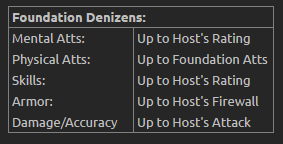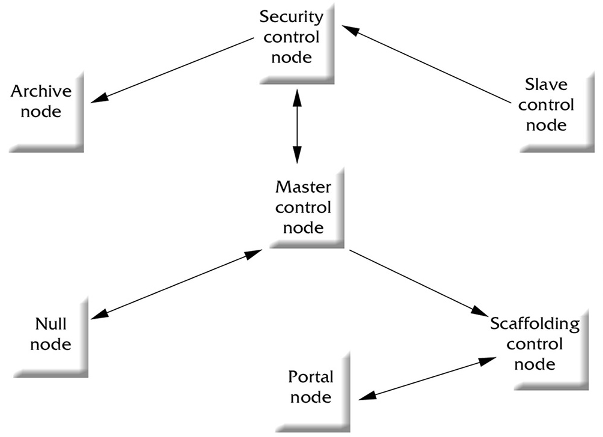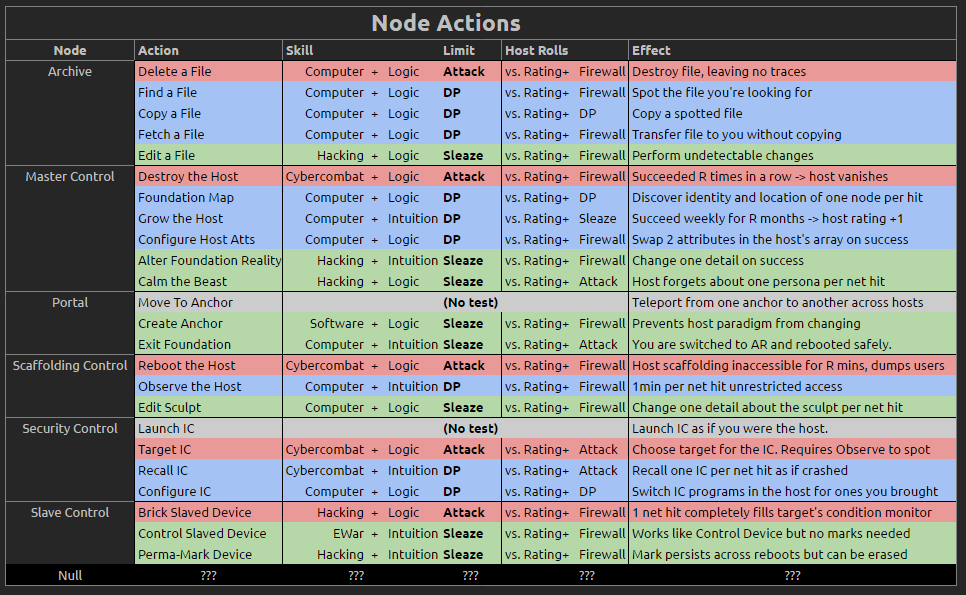Content
Links
Wiki Users
Contact
Foundations
Foundations are a relatively esoteric part of the Shadowrun 5e Matrix. This page is designed to clearly summarise some of the essential rules from Data Trails for playing in a Foundation. This page is not intended to replace all the cool fluff and things from the original work, so please reference the Data Trails sourcebook for more detailed thematic information. Please see the Foundations section on the House Rules page for Runnerhub-specific rulings regarding Foundations.
A quick reference to the mechanics of Foundations and some of the information on this page can be found here.
Entering a Foundation
Every host has an entryway to its own unique Foundation within it somewhere. You can enter the Foundation by getting a mark in the normal way on the entryway and then performing an "Enter Foundation" complex action, at which point your persona vanishes from the host, and as such is no longer target-able from outside the Foundation.
When you enter a Foundation, there is no guarantee that you will end up in any specific portion of the Foundation, or even appear with your companions at your side. In many cases, you'll all be scattered throughout the landscape of the Foundation. However, it can be noted that use of the Hitchhiker program increases your chances of appearing alongside the hitchhiking teammate (at the GM's discretion).
Entering a Foundation is addictive (Addiction Rating 5, Threshold 1, Psychological).
Actions in a Foundation
Within a Foundation, your stats change a bit. Your attributes and skill ratings change in accordance with the following tables:

And, for GMs, the Foundation NPCs use the following stats:

Matrix Programs
- Agents and Pilot Programs cannot enter a Foundation
- Matrix programs cannot be reconfigured while inside a Foundation.
- Standard Matrix actions cannot be performed from inside a Foundation.
Magic
- Magic cannot be used within a Foundation, unless the Paradigm contains a form of magic.
- Magic of a Foundation's Paradigm does not necessarily have to function the same way as it does in the real world.
- Paradigm-based magic uses the appropriate Foundation skill, as based on the table above.
- Spells cannot be sustained from within a Foundation.
- Buffs from outside the Foundation that are affecting one's meat (Improved Attribute, Improved Ability, etc.) still apply while in the Foundation.
Resonance
- Resonance actions function as normal within a Foundation.
- Anything living within a Foundation is considered a persona for the purpose of Resonance actions.
- Everything else is considered a device for the purpose of Resonance actions.
- Fading is always taken as physical damage.
- Resonance powers may create variance unless they fit the Paradigm.
Damage
- All damage is taken as physical biofeedback.
- If a target does not have a physical condition monitor, then it is taken as Matrix damage.
- If you are forcibly unplugged while in a Foundation, you die.
The Paradigm
Everything within a Foundation follows what is called the Paradigm, which is basically the "setting" of the Foundation. The Paradigm can be anything at all, from a (mostly) normal Sixth World, to a replication of the year 2016, to an old horror movie, and to anything and everything in between. All actions (including how you talk to the other runners) must be in accordance to the Paradigm, or else the Foundation will get confused and realise that someone is inside it who is not supposed to be.
When a runner enters a Foundation, their appearance and physical form will change to fit within the context of the Paradigm (e.g. an elf runner in a Paradigm where elves don't exist might get turned into a human.).
Variance
The act of triggering the Foundation to realise that you are not a part of it is called Variance. Any action that does not fall in line with the Paradigm has a chance of triggering Variance.
- If the action is just slightly out of line with what the logic of the Paradigm of the Foundation expects, the host makes a Minor Variance threshold test
Firewall (4). - If the action is significantly out of line with or otherwise disruptive to the Paradigm, the host makes a Major Variance threshold test
Firewall + Rating (4).
If the threshold is met, Variance is triggered by the player. Furthermore, hits on a Variance test are recorded and trigger Variance at 40 (So pretty much the same as Overwatch). If a host glitches a Variance test, the relevant player's Variance score is reduced by one. If a host critically glitches a Variance test, the relevant player's Variance Score is reduced by half. Variance and Variance Scores are kept on an individual basis, meaning that if one runner triggers Variance, that does not mean that Variance is triggered for the other runners.
When Variance is triggered, everything in the world will start to attempt to brutally murder the Variance'd runner until a Calm the Beast action is successfully taken at the Master Control Node. Note that this is not relevant to just living things; inanimate objects will also attempt to hinder the runner from doing anything to resist the Foundation (Doors might be locked when they otherwise would not have been, guns might jam, etc.).
Nodes
Foundations are made up of what are called nodes, which are the structures that control the host and the Foundation itself. Foundations always contain the same nodes, and the nodes are always located upon the same mapping of metaphorical pathways, called the Data Trails:

Nodes can appear as any entity inside a Foundation (object, place, person, you name it), and do not necessarily have any metaphorical symbolism toward the functionality of the node in the way that normal Matrix iconography would. Each of the nodes has a different functionality, with a different test associated to each node action. Node actions can be performed when in contact with a node (which may be physical contact for an object, or more abstract, such as the rulebook example of playing a particular piece of music). Here is a quick overview of what you can do with each node and the respective tests:

Some notes on node actions:
- All node actions are Complex Actions.
- All node actions cause Variance upon failure:
- A tie results in a Minor Variance.
- Any net hits on the part of the Host results in a Major Variance.
Final Words
That should be the basics of what you know to brave the perils of a Foundation and start bricking some hosts. Happy hacking, chummer!